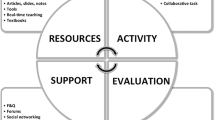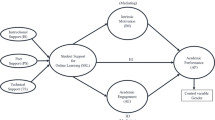Abstract
This paper aims at investigating students’ perceptions about assessment, especially the ways in which it is put into practice. Data were collected through questionnaires in different programmes in Portugal and Sweden. In total, 173 students from Portugal and 72 from Sweden participated in the study. Findings showed that students had similar ideas about assessment, such as verification of knowledge and learning, tests and grades. Their experiences of assessment methods used varied in the two countries, which can partly be explained by differences in national education systems. A learner-oriented perspective is prominent in the use of assessment methods, but at the same time student influence on assessment is perceived as low in both countries. Implications of the findings are analysed, namely issues regarding a learner-oriented perspective and the effectiveness, influence, trust, times and methods of assessment.
Similar content being viewed by others
References
Agency for Assessment and Accreditation of Higher Education. (2013). Manual de Avaliação [Evaluation Manual], version 1.1. http://www.a3es.pt/pt/acreditacao-e-auditoria/manual-de-avaliacao/manual-de-avaliacao. Accessed 2 November 2014.
Biggs, J. (2003). Teaching for quality learning at university. Buckingham: SHRE Open University Press.
Birenbaum, M. (1996). Assessment 2000: Towards a pluralistic approach to assessment. In M. Birenbaum & F. Dochy (Eds.), Alternatives in assessment of achievements, learning processes and prior knowledge (pp. 3–30). Boston: Kluwer.
Birenbaum, M., & Feldman, R. (1998). Relationships between learning patterns and attitudes towards two assessment formats. Educational Research, 40(1), 90–97.
Boud, D. (1990). Assessment and the promotion of academic values. Studies in Higher Education, 15(1), 1–11.
Boud, D. (1995). Assessment and learning: Contradictory or complementary? In P. Knight (Ed.), Assessment for learning in higher education (pp. 35–48). London: Kogan Page Limited.
Boud, D., & Falchikov, N. (2006). Aligning assessment with long-term learning. Assessment and Evaluation in Higher Education, 31(4), 399–413.
Brew, C., Riley, P., & Walta, C. (2009). Education students and their teachers: Comparing views on participative assessment practices. Assessment and Evaluation in Higher Education, 34(6), 641–657.
Brown, S., & Knight, P. (1994). Assessing learners in higher education. London: Kogan Page.
Carless, D. (2015). Exploring learning-oriented assessment processes. Higher Education, 69(6), 963–976.
Craddock, D., & Mathias, H. (2009). Assessment options in higher education. Assessment and Evaluation in Higher Education, 34(2), 127–140.
Declaration, Bologna. (1999). Joint declaration of the European Ministers of Education. Bologna: The European Higher Education Area.
Dochy, F., Segers, M., & Sluijsmans, D. (1999). The use of self-, peer and co-assessment in higher education: A review. Studies in Higher Education, 24(3), 31–50.
Duncan, T., & Buskirk-Cohen, A. (2011). Exploring learner-centered assessment: A cross-disciplinary approach. International Journal of Teaching and Learning in Higher Education, 23(2), 246–259.
Entwistle, N. J. (1991). Approaches to learning and perceptions of the learning environment. Introduction to the special issue. Higher Education, 22(3), 201–204.
Entwistle, N. J., & Entwistle, A. (1991). Contrasting forms of understanding for degree examinations: The student experience and its implications. Higher Education, 22(3), 205–227.
Eurydice. (2015). National education systems, higher education. https://webgate.ec.europa.eu/fpfis/mwikis/eurydice/index.php/Sweden:Higher_Education. Acessed 13 January 2015.
Fletcher, R., Meyer, L., Anderson, H., Johnston, P., & Rees, M. (2012). Faculty and students conceptions of assessment in higher education. Higher Education, 64(1), 120–133.
Flores, M. A., Veiga Simão, A., Barros, A., & Pereira, D. (2015). Perceptions of effectiveness, fairness and feedback of assessment methods: A study in higher education. Studies in Higher Education, 40(9), 1523–1534.
Gibbs, G., & Simpson, C. (2004). Does your assessment support your students’ learning? Journal of Learning and Teaching in Higher Education, 1, 3–31.
Gilles, J. L., Detroz, P., & Blais, J. G. (2011). An international online survey of the practices and perceptions of higher education professors with respect to the assessment of learning in the classroom. Assessment and Evaluation in Higher Education, 36(6), 719–733.
Goubeaud, K. (2010). How is science learning assessed at the postsecondary level? Assessment and grading practices in college biology, chemistry and physics. Journal of Science Education and Technology, 19(3), 237–245.
Goubeaud, K., & Yan, W. (2004). Teacher educators’ teaching methods, assessments, and grading: A comparison of higher education faculty’s instructional practices. The Teacher Educator, 40(1), 1–16.
Hernández, R. (2012). Does continuous assessment in higher education support student learning? Higher Education, 64(4), 489–502.
Huba, M. E., & Freed, J. (2000). Learner-centered assessment on college campuses: Shifting the focus from teaching to learning. Boston, MA: Allyn and Bacon.
Lew, M., Alwis, W., & Schmidt, H. (2009). Accuracy of students’ self-assessment and their beliefs about its utility. Assessment and Evaluation in Higher Education, 35(2), 135–156.
Lewis-Beck, M., Bryman, A., & Liao, T. (2004). The SAGE encyclopedia of social science research methods (Vol. III). California: SAGE Publications.
Light, G., & Cox, R. (2003). Learning and teaching in higher education: The reflective professional. London: Sage Publications.
Lindblom-Ylänne, S., Trigwell, K., Nevgi, A., & Ashwin, P. (2006). How approaches to teaching are affected by discipline and teaching context. Studies in Higher Education, 31(3), 285–298.
Lizzio, A., & Wilson, K. (2013). First-year students’ appraisal of assessment tasks: Implications for efficacy. Engagement and performance. Assessment and Evaluation in Higher Education, 38(4), 389–406.
Lueddeke, G. (2003). Professionalising teaching practice in higher education: a study of disciplinary variation and ‘teaching-scholarship. Studies in Higher Education, 28, 213–228.
Marton, F., & Säljö, R. (1997). Approaches to learning. In F. Marton, D. Hounsell, & N. Entwistle (Eds.), The experience of learning. Implications for teaching and studying in higher education (pp. 39–59). Edinburgh: Scottish Academic Press.
McDowell, L., & Mowl, G. (1996). Innovative assessment—Its impact on students. In G. Gibbs (Ed.), Improving student learning through assessment and evaluation (pp. 131–147). Oxford: The Oxford Centre for Staff Development.
McGarr, O., & Clifford, A. (2013). ‘Just enough to make you take it seriously’: Exploring students’ attitudes towards peer assessment. Higher Education, 65(6), 677–693.
Ministry of Science, Technology and Higher Education. (2005). Decree Law no. 42/2005. Lisbon.
Mok, M., Lung, C., Cheng, D., Cheung, R., & Ng, M. (2006). Self-assessment in higher education: Experience in using a metacognitive approach in five case studies. Assessment and Evaluation in Higher Education, 31(4), 415–433.
Mälardalen University. (2015a). Education plan for initial teacher education, pre-school and year 1–3, 240 ECTS. Västerås.
Mälardalen University. (2015b). Course plan for development work and evaluation/Utvecklingsarbete och utvärdering, 7,5 ECTS. Västerås.
Mälardalen University. (2015c). Regler och anvisningar för examinationsärenden på grundnivå och avancerad nivå vid Mälardalens högskola [Rules and regulations for exam issues on first cycle and second cycle (advanced level) at Mälardalen University]. Västerås.
Nieweg, M. (2004). Case study: Innovative assessment and curriculum redesign. Assessment and Evaluation in Higher Education, 29(2), 203–214.
Norrie, E. (2003). Mark my words: Self and peer assessment as an aid to learning. European Journal of Engineering Education, 28(1), 103–116.
Paris, S., & Paris, A. (2001). Classroom applications of research on self-regulated learning. Educational Psychologist, 36(2), 89–101.
Pereira, D., & Flores, M. A. (2012). Percepções dos estudantes universitários sobre a avaliação das aprendizagens: Um estudo exploratório. Avaliação (Campinas), 17(2), 529–556.
Pereira, D., Flores, A. M., & Niklasson, L. (2015). Assessment revisited: A review of research in assessment and evaluation in higher education. Assessment and Evaluation in Higher Education,. doi:10.1080/02602938.2015.1055233.
Price, M., Rust, C., O’Donovan, B., Handley, K., & Bryant, R. (2012). Assessment literacy: The foundation of improving student learning. Oxford: Oxford Centre for Staff and Learning Development.
Race, P. (1995). What has assessment done for us—And to us? In P. Knight (Ed.), Assessment for learning in higher education (pp. 61–74). London: Kogan Page.
Ramsden, P. (1992). Learning to teach in higher education. London: Routledge.
Rust, C. (2007). Towards a scholarship of assessment. Assessment and Evaluation in Higher Education, 32(2), 29–37.
Sambell, K., & McDowell, L. (1998). The construction of the hidden curriculum: Messages and meanings in the assessment of student learning. Assessment and Evaluation in Higher Education, 23(4), 391–402.
Sambell, K., McDowell, L., & Brown, S. (1997). ‘But is it fair?’: An exploratory study of student perceptions of the consequential validity of assessment. Studies in Educational Evaluation, 23(4), 349–371.
Scouller, K. (1998). The influence of assessment method on students’ learning approaches: Multiple choice question examinations versus assignment essay. Higher Education, 35(4), 453–472.
Segers, M., & Dochy, F. (2001). New assessment forms in problem-based learning: The value added of the students’ perspective. Studies in Higher Education, 26(3), 327–343.
Struyven, K., Dochy, F., & Janssens, S. (2005). Students´ perceptions about evaluation and assessment in higher education: a review. Assessment and Evaluation in Higher Education, 30(4), 325–341.
Swedish Higher Education Authority. (2015). http://www.uka.se/qualityassurance/qualityaspectsandconditionsonwhichdegreeawardingpowersarebased.4.4149f55713bbd917563800010322.html#h-Qualityaspects. Accessed 13 January 2015.
Taras, M. (2010). Student self-assessment: Processes and consequences. Teaching in Higher Education, 15(2), 199–209.
Teichler, U. (2014). Opportunities and problems of comparative higher education research: The daily life of research. Higher Education, 67(4), 393–408.
Vickerman, P. (2009). Student perspectives on formative peer assessment: An attempt to deepen learning? Assessment and Evaluation in Higher Education, 34(2), 221–230.
Webber, K. (2012). The use of learner-centered assessment in US colleges and universities. Research in Higher Education, 53(2), 201–228.
Weurlander, M., Söderberg, M., Scheja, M., Hult, H., & Wernerson, A. (2012). Exploring formative assessment as a tool for learning: Students’ experiences of different methods of formative assessment. Assessment and Evaluation in Higher Education, 37(6), 747–760.
Yanowitz, K. L., & Hahs-Vaughn, D. (2007). Changes in student-centered assessment by postsecondary science and non-science faculty. Teaching in Higher Education, 12, 171–184.
Yorke, M. (2003). Formative assessment in higher education: Moves towards theory and the enhancement of pedagogic practice. Higher Education, 45(4), 477–501.
Acknowledgments
This work was supported by the Portuguese Foundation for Science and Technology under Grant No SFRH/BD/76175/2011.
Author information
Authors and Affiliations
Corresponding author
Rights and permissions
About this article
Cite this article
Pereira, D., Niklasson, L. & Flores, M.A. Students’ perceptions of assessment: a comparative analysis between Portugal and Sweden. High Educ 73, 153–173 (2017). https://doi.org/10.1007/s10734-016-0005-0
Published:
Issue Date:
DOI: https://doi.org/10.1007/s10734-016-0005-0




